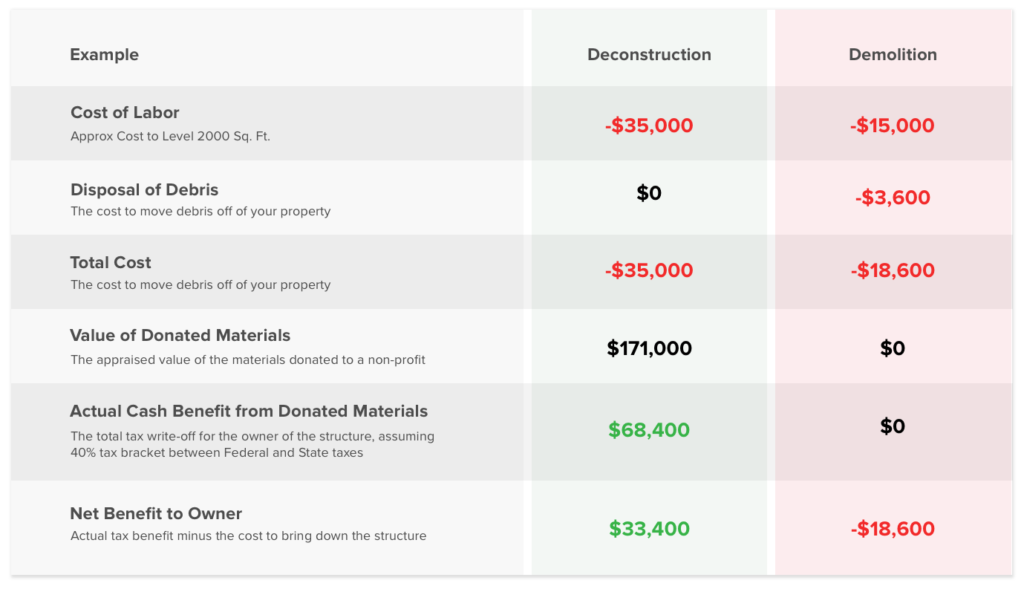How Deconstruction Can Benefit Real Estate Agents and Their Clients

Imagine you have clients who want to renovate or rebuild their properties but they are struggling to come to terms with the substantial costs. Traditionally, clients undergoing this process, and real estate agents helping them, have strictly looked at costly demolition processes to clear away the undesired property. The high costs for demolishing usually make sense since you need to account for the labor, the haul-away, and the disposal of the preexisting structure, fixtures, and furniture. However, what if there was another option that provided lower long-run costs through tax-deductible donations? This is how deconstruction benefits real estate professionals and their clients.
Before you begin assisting your clients with their renovation or rebuilding project, you will probably research costs for the individual steps to help get their new home. Demolishing the pre-existing structure and getting rid of all of the material is the first step. The national average cost for demolishing a 1,000 sq. foot home falls somewhere around $9,000. If your home is somewhere around 2,000 sq. feet, the cost–simply to clear away the foundation to begin rebuilding– jumps up to about $19,000.
After you get past accepting this inevitable cost, you need to gauge the rebuilding and renovation expenses. For a 1,000 sq. foot space, your average rebuilding cost is around $107,000, and for a 2,000 sq. foot space, it is around $210,000. You pull out your calculator tally up the numbers and then take a deep breath after you see the screen reveal total costs to be $116,000 and $229,000 respectively. Are you sure you want to do this?
Clients burdened by these massive costs will typically suggest turning to remodeling, believing that by eliminating the demolition aspect and needing to start anew, they can work with what they already have and make the process cheaper. But, the fun really begins the moment you tear off that first drywall only to uncover mold issues, rotted wood, damaged wiring, or cracked foundations making you wish you reconsidered choosing to rebuild your new home on top of an inescapably damaged foundation. Either way, these options leave your clients financially uncomfortable, and they ask you if there is any way to sell the materials in the house to make some money and take down the total costs of this project. I am here to tell you there is; it’s called deconstruction.
With demolishing and renovating, your clients are forced to throw away so many materials to make room for their new home. Doing this does not mean that they are irresponsible or wasteful, but it may be a necessary feat to proceed with your project. These materials do have value, and through deconstruction they can extract the value out of these materials, leveraging their fair-market value, and ultimately transforming renovations and demolitions into potentially value-added services. How do you do this? Instead of demolishing, consider deconstruction.
Deconstruction is not as complicated as it may initially seem. The first step is to disassemble the current structure, separating the reusable pieces from the non-reusable ones. After that is done, you will have a collection of materials ready to be given a second life by donating them all to a 501(c)3 charity like the Second Chance, or Habitat for Humanity. How much can you honestly get back from these materials? Well, according to the US Tax Code, the full fair market value of the donated materials is tax deductible, which means you can get back up to 40% of the total value. All of those materials would have been wasted in demolition or remodeling, but now you can reap monetary benefits from the reusable building materials, allowing you to significantly diminish the overall cost of your entire project.
You may be convincing yourself that the deconstruction process itself and hiring people to pick apart the current structure and bring all of the materials to a charity will be way more expensive than having a team come and recklessly hammer away and demolish what was initially there. However, since deconstruction reduces waste and reuses materials instead of unnecessarily destroying, any expenses above typical demolition expenses can also be tax deductible, and it may also qualify for LEED points keeping the project in compliance with local environmental and governmental regulations. Further, by presenting this option to your clients and showing them how you can help them save money, they will be more inclined to work with you over your competitors.
Still unconvinced? Let’s look at the numbers in a clear breakdown of where the costs lie:

The amount of money clients can save through deconstruction can vary depending on the quality of the building materials in their house. Reach out to our team at Green Donation Consultants to get a free estimation of the fair market value of your home’s materials.